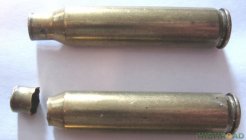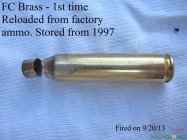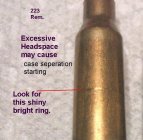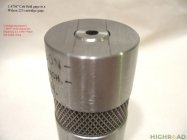Gotcha. I still ONLY trust the actual chamber. Measuring shoulder bump with instruments just isn't for me. I'm not saying it's bad... just not my way of skinning the proverbial cat.Like I said. Or if I didn’t I’m about to, I’m so close to .002 bump it’s scary. Some cases come out .001 some at .003 I sure that’s way less than many around the world
You are using an out of date browser. It may not display this or other websites correctly.
You should upgrade or use an alternative browser.
You should upgrade or use an alternative browser.
Got brass troubles. Cause ? Video posted
- Thread starter DLT
- Start date
DLT
Silver $$ Contributor
Your correct where the taper stops is where the case split. The barrel doesn’t have excess head space though. I installed it on a go gauge and I used 1 piece of scotch tape for my no go gauge. The go gauge and a new piece of brass measured within a couple thousands of each other best I can remember. UNLESS some freak thing has happened to my sizing process but I don’t see what
DLT
Silver $$ Contributor
So you set your dies with for a snug bolt fall ??? Don’t measure anything ???Gotcha. I still ONLY trust the actual chamber. Measuring shoulder bump with instruments just isn't for me. I'm not saying it's bad... just not my way of skinning the proverbial cat.
Ned Ludd
Silver $$ Contributor
As 358WCF noted, casehead separation usually occurs at the end of the case wall taper, which is a mechanically weak spot during the elongation/compression process as we fire and re-size the brass. Solely based on that observation, it would seem as though excessive elongation/compression could have been a contributing factor. However, what you described doesn't sound like a crazy hot load to me by any stretch, and it also doesn't sound like you were overworking the brass via excessive shoulder bump.
I am also surprised at how far up from the case head the wall taper ends; it's usually much lower. I've never cut open a piece of Starline .223 Rem brass before, but that could be indicative of a manufacturing defect or some sort of Lot-specific issue if Starline brass casewalls don't normally look like that when cut open. I think you did the right thing by contacting Starline. Such issues are not always easy to solve definitively on an internet shooting forum. Let us know what you find out.
I am also surprised at how far up from the case head the wall taper ends; it's usually much lower. I've never cut open a piece of Starline .223 Rem brass before, but that could be indicative of a manufacturing defect or some sort of Lot-specific issue if Starline brass casewalls don't normally look like that when cut open. I think you did the right thing by contacting Starline. Such issues are not always easy to solve definitively on an internet shooting forum. Let us know what you find out.
DLT
Silver $$ Contributor
Oh I will. I have other brass I can test with, and hopefully a different lot of starline I also have on hand.As 358WCF noted, casehead separation usually occurs at the end of the case wall taper, which is a mechanically weak spot during the elongation/compression process as we fire and re-size the brass. Solely based on that observation, it would seem as though excessive elongation/compression could have been a contributing factor. However, what you described doesn't sound like a crazy hot load to me by any stretch, and it also doesn't sound like you were overworking the brass via excessive shoulder bump.
I am also surprised at how far up from the case head the wall taper ends; it's usually much lower. I've never cut open a piece of Starline .223 Rem brass before, but that could be indicative of a manufacturing defect or some sort of Lot-specific issue if Starline brass casewalls don't normally look like that when cut open. I think you did the right thing by contacting Starline. Such issues are not always easy to solve definitively on an internet shooting forum. Let us know what you find out.
Its caused by excessive stretching of the brass on firing.I had a case separate today
Factory new brass can be damaged on the first firing. The case head to datum measurement is normally short, leaving a lot of room for case stretch. Add a large chamber or excessive chamber headspace, brass will fail. No fixing it. May take a few firings.
Method of sizing needs looked at. If the shell holder contacts the bottom of a RCBS fl die, shoulder set back is normally no more the .005" Not going to cause case separations.
A Dillon progressive can set shoulders back as much as .014" The Forster press, may allow it also.
Your 2 loads. 1 is maximum, the other starting. Starting loads or reduced loads may make for a shorter head to datum measurement, after firing. . The case body expands outward, pulling the shoulder back. Shorter head to datum.
When a hotter load is fired in this brass, extra stretching of the brass is done.
It may take 3 firings to fully expand new brass to your chamber. Start by sizing with a .010" gap between shell holder & Fl die. Adjust as needed so closing the bold provides a crush fit. Just closing the bold can size, push shoulder back .001" or more. Same in M16 by letting bolt slam on chambered rounds.
When the neck/shoulder is annealed, the case body below is stress releaved between 450F to 500F degrees. This is a known good thing when manufacturing brass.My anneal
Winchester NATO 5.56 ammo had separations in the case body like yours, in a full auto. It was found to need 1 more anneal.
5.56 brass is made for 1 firing. Anealing it helps or use bushing die on necks.
I find a case gauge to be useless.
Attachments
I agree with everything you said. I wouldn't argue any of it. But..... The OP is seeing failures with only four cycles, from a known brand of brass that has had similar issues in the past. I do not believe that your answer is the problem in this instance. I've run trash brass (mil junk and range pick up) through gas guns for many more cycles (10+ loads) and each trip through the sizer die shows a 5-7 thou shoulder bump to fit my case gauge set for maximum headspace since they can be shot from an assortment of chambers. I'll see lose primer pockets in the next few cycles but never a seperation. I anneal the snot out of these cases and get teh heat line 3/8" below the shoulder. I suspect it's a brass issue on this one. Hopefully Starline reaches out and gets to the bottom of it for us allIts caused by excessive stretching of the brass on firing.
Factory new brass can be damaged on the first firing. The case head to datum measurement is normally short, leaving a lot of room for case stretch. Add a large chamber or excessive chamber headspace, brass will fail. No fixing it. May take a few firings.
Method of sizing needs looked at. If the shell holder contacts the bottom of a RCBS fl die, shoulder set back is normally no more the .005" Not going to cause case separations.
A Dillon progressive can set shoulders back as much as .014" The Forster press, may allow it also.
Your 2 loads. 1 is maximum, the other starting. Starting loads or reduced loads may make for a shorter head to datum measurement, after firing. . The case body expands outward, pulling the shoulder back. Shorter head to datum.
When a hotter load is fired in this brass, extra stretching of the brass is done.
It may take 3 firings to fully expand new brass to your chamber. Start by sizing with a .010" gap between shell holder & Fl die. Adjust as needed so closing the bold provides a crush fit. Just closing the bold can size, push shoulder back .001" or more. Same in M16 by letting bolt slam on chambered rounds.
Dan
Last edited:
only four cycles
My Dillon RL-450 set shoulders back .014" at the 1 station. It took a few firings till they separated. (Defective shell plate, and no gauge to check bump in 1979.)Factory new brass can be damaged on the first firing.
Yes, it can be new defective brass. But still needs to stretch on firing. How much may be the issue? "New Barrel, headsapced with tape" ?
Time will tell, when OP uses a different lot of brass.
That's better headspace than many factory Remington 700 chambers ; ) I headspaced with tape on my 6BR and 6XC chambers. 28 loads on my br brass before pockets started to loosen and that's FL resizing one and a half to two thou bump every cycle. Yes, .014" is too much. He's probably no more than .005. Different scenarios.? "New Barrel, headsapced with tape" ?
Time will tell, when OP uses a different lot of brass.
DLT
Silver $$ Contributor
It’s a savage. Piles of people only use a go gauge Then they make their no go with 1 or 2 pieces of scotch tape on the back. What I learned while setting my barrel up on the forums. If it’s a head space issue it’s my sizing, sure not the barrel unless my go gauge was out of specMy Dillon RL-450 set shoulders back .014" at the 1 station. It took a few firings till they separated. (Defective shell plate, and no gauge to check bump in 1979.)
Yes, it can be new defective brass. But still needs to stretch on firing. How much may be the issue? "New Barrel, headsapced with tape" ?
Time will tell, when OP uses a different lot of brass.
DLT
Silver $$ Contributor
I took a notion to cut open a new bag of starline from midway split a case and see what I could. This is what it looked like
Is it a uh oh or normal ? Click the picture or video it should play
Is it a uh oh or normal ? Click the picture or video it should play
Last edited:
Where is line is occurring it’s .920 up from the bottom of case head. The area measures .365 diameter. A new unsized unfired piece I got .361 I don’t think chamber is too fat with those numbers ?
I have multiple .223 cases fired several times from different bolt guns- all with custom barrels having SAAMI chambers- no tight match. My measurements at this datum the OP referenced show .363"-364 " diameter. Granted it is hard to get a precise measurement on a tapered case OD but if the OP's measures .365"-that to me is oversize and the brass has to flow somewhere to fill the larger cavity (i.e. chamber). The .223 case being rather small, it should resize relatively easy despite the fact the die is undersize for this new chamber.Its caused by excessive stretching of the brass on firing.
Factory new brass can be damaged on the first firing. The case head to datum measurement is normally short, leaving a lot of room for case stretch. Add a large chamber or excessive chamber headspace, brass will fail. No fixing it. May take a few firings
Reply from Starline directly when I asked them if there were any current recalls:
Dan,
We don’t currently have any plans for a recall on 223 brass. I’ve only got one customer that I’m aware of having problems right now, and his chamber appears to be a little larger just behind the shoulder than it is a little farther back. Most likely causing his separations. The Lot’s of 223 are generally between 1.5 million and 4 million cases, so if there was a widespread problem we would have expected to have heard about it by now. It is one of our best selling products and we rarely have any complaints on the 223 Remington, so I’d say you are good to go. We did have a recall a couple of years ago on 5.56, but that was a splitting issue that didn’t affect the 223 Rem.
Regards,
Hunter Pilant
Process Manager
Chief Ballistician
hunter@starlinebrass.com
Dan,
We don’t currently have any plans for a recall on 223 brass. I’ve only got one customer that I’m aware of having problems right now, and his chamber appears to be a little larger just behind the shoulder than it is a little farther back. Most likely causing his separations. The Lot’s of 223 are generally between 1.5 million and 4 million cases, so if there was a widespread problem we would have expected to have heard about it by now. It is one of our best selling products and we rarely have any complaints on the 223 Remington, so I’d say you are good to go. We did have a recall a couple of years ago on 5.56, but that was a splitting issue that didn’t affect the 223 Rem.
Regards,
Hunter Pilant
Process Manager
Chief Ballistician
hunter@starlinebrass.com
DLT
Silver $$ Contributor
I strip the bolt so the firing pin, firing pin spring, and ejector doesn’t have any drag. I left my extractor intact . Once I had a couple firings on a piece of brass I started by backing my sizing die out. I sized little by little and each time putting the sized case in the chamber and seeing if the bolt would close without any resistance. Once the die bumps it enough it will. Then I checked 2 or 3 more cases with that setting and made sure the bolt closed with no effort. DoneGood video.
Since this is a Savage, describe how you do the 'stripped bolt' proceedure, if you will.
Thanks! -Al
DShortt
Gold $$ Contributor
I'm not an expert on brass but that looks very normal to me. Perhaps making a chamber cast is in order so there's no question as to what you're dealing with.
Even if your headspace/sizing is off a bit the separations you are seeing is not in the place I've seen it previously. Usually it's much closer to the case head.
Even if your headspace/sizing is off a bit the separations you are seeing is not in the place I've seen it previously. Usually it's much closer to the case head.
DLT
Silver $$ Contributor
Did you see the low looking spot inside halfway up the case in the reflection ? That wrinkle or what ever it is doesn’t transfer to the outside of the case.I'm not an expert on brass but that looks very normal to me. Perhaps making a chamber cast is in order so there's no question as to what you're dealing with.
Even if your headspace/sizing is off a bit the separations you are seeing is not in the place I've seen it previously. Usually it's much closer to the case head.
DShortt
Gold $$ Contributor
I do but it almost looks to me like the finish inside the case is just finer in that area and above. (?) Unless I'm not looking at the same spot because a similar area is visible about 3/4 of the way up the case.Did you see the low looking spot inside halfway up the case in the reflection ? That wrinkle or what ever it is doesn’t transfer to the outside of the case.
Again, I'm no expert on brass. Any case head separations I had in the past were on a 260Rem and they had 20 or more firings on them. This was even before I was aware of shoulder bump so I was just setting the die according to manufacturer instructions.
nakneker
Gold $$ Contributor
I bought 2k pieces 223 brass back 5/22. Most of it is unused but I did load 200 pieces of it for two bolt action 223s, on my third firing with no issues that I’m aware of. I’ll look closer when I get home though.
If Starline produces 1-4 million per lot you would think if a problem existed that more guys would be contacting them. Doesn’t mean an issue doesn’t exist though, like the 1800 I have in my AR stash that aren’t being used, lots of new brass doesn’t get put into the rotation straight away. Just thinking out loud.
If Starline produces 1-4 million per lot you would think if a problem existed that more guys would be contacting them. Doesn’t mean an issue doesn’t exist though, like the 1800 I have in my AR stash that aren’t being used, lots of new brass doesn’t get put into the rotation straight away. Just thinking out loud.
Similar threads
Upgrades & Donations
This Forum's expenses are primarily paid by member contributions. You can upgrade your Forum membership in seconds. Gold and Silver members get unlimited FREE classifieds for one year. Gold members can upload custom avatars.

Click Upgrade Membership Button ABOVE to get Gold or Silver Status.
You can also donate any amount, large or small, with the button below. Include your Forum Name in the PayPal Notes field.
To DONATE by CHECK, or make a recurring donation, CLICK HERE to learn how.

Click Upgrade Membership Button ABOVE to get Gold or Silver Status.
You can also donate any amount, large or small, with the button below. Include your Forum Name in the PayPal Notes field.
To DONATE by CHECK, or make a recurring donation, CLICK HERE to learn how.













